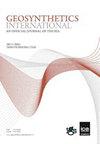Effects of induced trench configuration and EPS geofoam density on the HDPE pipe behavior
IF 3.3
2区 工程技术
Q2 ENGINEERING, GEOLOGICAL
引用次数: 0
Abstract
The effects of induced trench configuration and stiffness of compressible inclusion on the HDPE pipe behavior were investigated through full-scale laboratory tests. Two pipe-compressible inclusion configurations (“compressible inclusion over the pipe crown” and “the pipe covered with compressible inclusion”) were tested and EPS Geofoam with 10 and 15 kg/m³ nominal density was used as compressible inclusion. To simulate geostatic stresses imposed by high embankment fill, the surcharge stress up to 200 kPa was applied on the surface of the burial medium. Comprehensive instrumentation was implemented to measure the pipe deflections, soil stresses on the pipe, and soil settlements in the pipe zone. Considering the pipe behavior and cost-efficiency together, the configuration in which one EPS Geofoam panel with 10 kg/m³ nominal density is placed over the pipe crown arises as the optimal solution for the induced trench HDPE pipe. This solution provided a reduction in the vertical stress at the pipe crown up to of 76% and in the horizontal stress at the pipe springline up to of 65%. The vertical and horizontal pipe deflections are reduced by 87% and 60%, respectively, under 200-kPa surcharge stress. i.e., overburden pressure imposed by a 10-m-high embankment fill.诱导沟槽结构和EPS土工泡沫密度对HDPE管性能的影响
通过室内全尺寸试验,研究了诱导沟槽形态和可压缩夹杂物刚度对HDPE管材性能的影响。测试了两种管道可压缩包体结构(“可压缩包体覆盖管顶”和“可压缩包体覆盖管”),可压缩包体采用标称密度为10和15 kg/m³的EPS Geofoam。为了模拟高路堤填方所施加的地静力,在掩埋介质表面施加了高达200 kPa的附加应力。采用综合仪器测量了管道挠度、管道土体应力和管区土体沉降。考虑到管道的性能和成本效益,在管道顶部放置一块标称密度为10 kg/m³的EPS土工泡沫板的配置成为了HDPE管道的最佳解决方案。该解决方案可将管道顶部的垂直应力降低76%,将管道弹簧线上的水平应力降低65%。在200 kpa的附加应力下,垂直和水平管道挠度分别降低了87%和60%。即10米高的路堤填方施加的覆盖层压力。
本文章由计算机程序翻译,如有差异,请以英文原文为准。
求助全文
约1分钟内获得全文
求助全文
来源期刊

Geosynthetics International
ENGINEERING, GEOLOGICAL-GEOSCIENCES, MULTIDISCIPLINARY
CiteScore
6.90
自引率
20.00%
发文量
91
审稿时长
>12 weeks
期刊介绍:
An online only, rapid publication journal, Geosynthetics International – an official journal of the International Geosynthetics Society (IGS) – publishes the best information on current geosynthetics technology in research, design innovation, new materials and construction practice.
Topics covered
The whole of geosynthetic materials (including natural fibre products) such as research, behaviour, performance analysis, testing, design, construction methods, case histories and field experience. Geosynthetics International is received by all members of the IGS as part of their membership, and is published in e-only format six times a year.
 求助内容:
求助内容: 应助结果提醒方式:
应助结果提醒方式:


